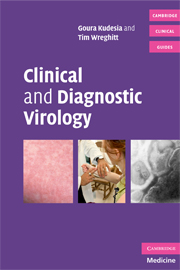Book contents
- Frontmatter
- Contents
- List of plates
- Preface
- Acknowledgements
- SECTION 1 INDIVIDUAL VIRUSES
- Introduction to virology
- 1 Adenoviruses
- 2 Arboviruses and haemorrhagic fever viruses
- 3 Cytomegalovirus (CMV)
- 4 Epstein–Barr virus (EBV)
- 5 Enteroviruses
- 6 Hepatitis A virus (HAV)
- 7 Hepatitis B and D viruses (HBV and HDV)
- 8 Hepatitis C virus (HCV)
- 9 Hepatitis E virus (HEV)
- 10 Herpes simplex virus (HSV)
- 11 Human immunodeficiency virus (HIV) and acquired immunodeficiency syndrome (AIDS)
- 12 Human herpes viruses types 6, 7 and 8 (HHV 6, 7 and 8)
- 13 Human T-cell leukaemia virus (HTLV)
- 14 Influenza viruses
- 15 Measles virus
- 16 Mumps virus
- 17 Noroviruses
- 18 Parainfluenza viruses
- 19 Papilloma and polyoma viruses
- 20 Parvovirus B19
- 21 Pox viruses
- 22 Rabies virus
- 23 Respiratory syncytial virus (RSV)
- 24 Rhinoviruses
- 25 Rotavirus
- 26 Rubella virus
- 27 SARS CoV and other coronaviruses
- 28 Varicella-zoster virus (VZV)
- SECTION 2 OTHER RELATED AGENTS
- SECTION 3 CLINICAL SYNDROMES
- SECTION 4 DIAGNOSTIC TECHNIQUES
- SECTION 5 PATIENT MANAGEMENT
- Index
- Plate section
14 - Influenza viruses
Published online by Cambridge University Press: 07 December 2009
- Frontmatter
- Contents
- List of plates
- Preface
- Acknowledgements
- SECTION 1 INDIVIDUAL VIRUSES
- Introduction to virology
- 1 Adenoviruses
- 2 Arboviruses and haemorrhagic fever viruses
- 3 Cytomegalovirus (CMV)
- 4 Epstein–Barr virus (EBV)
- 5 Enteroviruses
- 6 Hepatitis A virus (HAV)
- 7 Hepatitis B and D viruses (HBV and HDV)
- 8 Hepatitis C virus (HCV)
- 9 Hepatitis E virus (HEV)
- 10 Herpes simplex virus (HSV)
- 11 Human immunodeficiency virus (HIV) and acquired immunodeficiency syndrome (AIDS)
- 12 Human herpes viruses types 6, 7 and 8 (HHV 6, 7 and 8)
- 13 Human T-cell leukaemia virus (HTLV)
- 14 Influenza viruses
- 15 Measles virus
- 16 Mumps virus
- 17 Noroviruses
- 18 Parainfluenza viruses
- 19 Papilloma and polyoma viruses
- 20 Parvovirus B19
- 21 Pox viruses
- 22 Rabies virus
- 23 Respiratory syncytial virus (RSV)
- 24 Rhinoviruses
- 25 Rotavirus
- 26 Rubella virus
- 27 SARS CoV and other coronaviruses
- 28 Varicella-zoster virus (VZV)
- SECTION 2 OTHER RELATED AGENTS
- SECTION 3 CLINICAL SYNDROMES
- SECTION 4 DIAGNOSTIC TECHNIQUES
- SECTION 5 PATIENT MANAGEMENT
- Index
- Plate section
Summary
The viruses
Influenza A and B viruses are RNA viruses and belong to the family Myxoviridae. The RNA genome is split into eight segments, which allows the influenza A strains to exchange genetic information with each other giving rise to new strains all the time.
Both influenza A and B viruses have got two important surface proteins, namely haemagglutinin (H), which is responsible for attaching the virus to the cell surface, and neuraminidase (N). These two proteins are used in the nomenclature of strains (e.g. H2N3 and H5N1).
Epidemiology
Some influenza A strains infect other animals such as birds and pigs. Infections can spread from these animals to humans, sometimes causing an outbreak. We are most familiar with H5 (haemagglutinin type 5) and H7 (haemagglutinin type 7) strains transmitting from birds to humans. Usually, these infections are associated with single cases or clusters of cases in humans. There is always the fear that these avian viruses will mutate, becoming muchmore infectious to humans and causing a worldwide pandemic.
Influenza viruses are RNA viruses that mutate regularly (especially influenza Avirus). Viruses causing outbreaks one year are rarely the same as those causing outbreaks the following year. This is why the composition of influenza virus vaccines is different each year. This gradual change in RNA composition is called antigenic drift. It is thought that some new pandemics of influenza A arise because of antigenic shift, which usually occurs when two different strains of influenza A virus infect the same cell (especially in pigs, which can be infected with human strains).
- Type
- Chapter
- Information
- Clinical and Diagnostic Virology , pp. 69 - 72Publisher: Cambridge University PressPrint publication year: 2009
- 1
- Cited by



